Concrete is a popular construction material thanks to its strength and durability. Chances are that there is concrete on your property, whether it’s a driveway, patio, or walkway.
If you’re thinking about renovating these concrete features, you might wonder if pouring concrete over concrete is a good idea. Can you add a new layer of concrete to an existing structure to make it look new? The answer is yes, but only in some cases.
Can You Pour Concrete Over Existing Concrete?
You can add a layer of concrete over an existing feature as long as you follow a few best practices to ensure the overlay concrete will adhere to the existing material properly.
However, if the concrete structure has signs of damage, it’s best to remove or repair it. Adding a new layer of concrete will not address these structural issues, and the top layer will quickly develop issues.
When Would Someone Want to Pour Concrete Over Existing Concrete?

There are different use cases for adding a concrete overlay to an existing structure.
A common reason is to increase the height of a concrete feature. For instance, you can extend a concrete wall or make a walkway higher, so it aligns with your patio.
A new layer of concrete can also create a fresh look for your property. It can boost the curb appeal of your home, but keep in mind that pouring a new layer of concrete isn’t the best way to create a structure with optimal tensile and compressive strength.
If you’re serious about boosting the value of your property with a concrete structure, removing old concrete and pouring a new slab is the way to go.
Lastly, many homeowners opt to pour concrete over concrete to create a different finish. It’s possible to mix pigments into the overlay, create an aesthetic finish with a brushed texture, or use stamps and stencils to mimic the look of pavers.
When Shouldn’t You Pour Concrete Over Existing Concrete?
A new layer of concrete can hide cracks and other issues, but it’s not a viable option for repairing a slab of concrete. Cracks appear for a reason. If you don’t address the root causes behind the cracks, the concrete overlay will develop the same issues.
Cracks and other signs of stress can appear if the initial concrete slab doesn’t cure properly. It can happen if moisture evaporates too fast from the material. You can hide these cracks with a new layer of concrete, but your concrete structure will never reach its full tensile strength and cracks will be likely to appear again in the future.
Environmental factors can also cause a concrete structure to crack. Common examples include frost heave and tree roots. Pouring a new layer of concrete will hide the cracks, but the concrete overlay will crack the next time ice forms under the concrete structure or when tree roots continue to grow through the slab.
What Is the Process for Pouring Concrete Over Existing Concrete?
If you have a healthy structure that can support a concrete overlay, there are a few best practices to follow.
Bonding is an important consideration. Cement doesn’t have natural bonding agents, which means the new concrete will not bind to the old slab unless you use a bonding agent. If you fail to do so, the concrete slab will develop structural issues.
- Here’s how you can pour concrete over concrete:
- Start by preparing the surface. Fix any small cracks with a filler or patching compound.
- Next, apply a bonding agent to the concrete structure. You can also use an overlay layer.
- Create forms that will maintain the concrete in place as it cures. The forms should follow the shape and size of the existing structure.
- Mix the concrete and pour it. A concrete slab in direct contact with the ground should be at least 3 ½” thick, but the minimum thickness is only two inches when adding an overlay.
- Let the concrete cure. During this process, cement compounds will bind with water molecules to gain tensile strength. Keep the concrete overlay hydrated so it doesn’t dry out too quickly.
- Depending on the concrete you use, curing can take three to 10 days. Avoid walking on this surface or parking your vehicle on it.
Get Help With Your Concreting Projects

Is your concrete driveway healthy enough to add an overlay? If you’re not sure, it’s best to have a professional look at it.
At Richfield Concrete, renovating existing concrete structures is one of our specialties. We can assess if a concrete slab is a good candidate for an overlay or recommend other options. And with over 70 years of experience in concreting, you can count on us to deliver a high-quality result.Do you have a concrete structure you’d like to renovate? Contact us today to learn more about your options.





